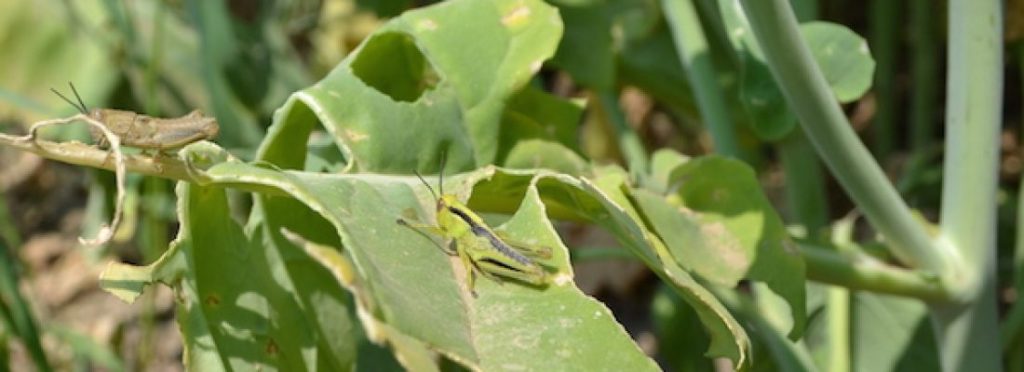Does Eco-Friendly Disease Control work?

If you are a gardener, farmer, or homeowner, you probably know how frustrating it can be to deal with pests and diseases that attack your plants and crops. You may have tried using various pesticides and fungicides to get rid of them, but you may have also wondered about the negative effects of these chemicals on your health, the environment, and the food chain. Is there a better way to control pests and diseases without harming yourself and the planet? The answer is yes: eco-friendly disease control.
What is Eco-Friendly Disease Control?
Using natural or biological agents to prevent or reduce the damage caused by pests and diseases in plants and crops is called eco-friendly disease control. These agents, such as microorganisms, insects, plants, or other natural substances, can suppress, repel, or kill harmful organisms without harming the beneficial ones. Eco-friendly disease control can also be known as biological control, biocontrol, or bioprotection. 1
Why Choose Eco-Friendly Disease Control Over Chemical Methods?
Compared to conventional chemical methods, eco-friendly disease control has many benefits. They are safer for humans, animals, and the environment, as it does not leave toxic residues or cause pollution. Also,it is more sustainable and cost-effective, as it does not require frequent applications or expensive equipment. Furthermore,they are more compatible with organic farming and integrated pest management (IPM) practices, as it does not interfere with the natural balance of the ecosystem. They are also more adaptive and resilient, as it can cope with changing conditions and reduce the risk of resistance development.2
How Does Eco-Friendly Disease Control Work?
Different strategies and mechanisms are used by eco-friendly disease control to achieve its goals.Some of these are:
• Competition: This involves using beneficial microorganisms that can outcompete or inhibit the growth of harmful microorganisms in the soil or on the plant surface. For example, some bacteria and fungi can produce antibiotics, enzymes, or siderophores that can suppress the pathogens. 3
• Predation: This involves using beneficial insects that can feed on or kill the harmful insects that damage the plants or crops. For example, ladybugs can eat aphids, lacewings can eat whiteflies, and parasitic wasps can lay eggs inside caterpillars 4
• Induced resistance: This involves using natural substances that can trigger the plant’s own defense system against pests and diseases. For example, some plant extracts, hormones, or elicitors can induce the production of phytoalexins, pathogenesis-related proteins (PRs), or other compounds that can enhance the plant’s immunity 5
• Antifeedant: This involves using natural substances that can deter or reduce the feeding behavior of harmful insects on the plants or crops. For example, some plant oils, extracts, or compounds can affect the taste, smell, or digestion of the insects 6
Examples of Eco-Friendly Disease Control in Action
Various insects and diseases that affect different plants and crops can be controlled effectively by eco-friendly disease control. For example:
• Biocontrol strategies: an eco-smart tool for integrated pest and diseases management: This is a special issue of BMC Microbiology that focuses on biocontrol approaches that can suppress the biotic stresses, alter plant defense mechanisms, and offer new eco-smart ways for controlling plant pathogens and insect pests under sustainable agriculture.7
• Host Plant Resistance: An Eco-Friendly Approach for Crop Disease Management: This is a book chapter that discusses how host plant resistance can be an eco-friendly approach for crop disease management. It covers the types, mechanisms, sources, evaluation methods, and breeding strategies of host plant resistance.
Eco-Friendly Pest Control from Custom Ag Intel: BioPowerD.
BioPowerD bioinsecticide contains a consortium of beneficial microbes reported to be effective at reducing insect counts of mosquitoes, grasshoppers and black flies. To learn more, click here.
Conclusion: The Benefits of Eco-Friendly Disease Control
Eco-friendly disease control is a better option than conventional chemical methods for humans and nature. It allows us to grow plants and crops that are healthy and productive without harming our health and environment. Moreover, it helps us protect our biodiversity and resources for future generations. You can see that eco-friendly disease control is possible and preferable.
How to Try Out Our BioPowerD Bioinsecticide
If you want to learn more about eco-friendly disease control or try out our BioPowerD yourself, you can call us on 1-855-476-4276 or email us at Info@customagintel.com.


Introduction
Agriculture can play a significant role in reducing greenhouse gas (GHG) emissions. However, several limiting factors need to be considered when using agriculture as part of the solution to reducing GHG emissions.
Limiting factors to consider
Here are some of the most significant limiting factors:
- Land use changes: Expanding agricultural land use can result in deforestation and the conversion of natural habitats, leading to increased GHG emissions from land use change. Therefore, agrarian expansion must be balanced with efforts to protect natural habitats and prevent deforestation.
- Intensive agriculture: Intensive agricultural practices, such as monoculture farming, can lead to soil degradation and loss of soil organic matter, resulting in increased GHG emissions. Sustainable agricultural practices, such as crop rotation, intercropping, and conservation agriculture, should be promoted to mitigate this.
- Fertilizer use: Fertilizer use can lead to GHG emissions, as nitrogen fertilizers can release nitrous oxide, a potent GHG. Reducing fertilizer use and promoting alternative fertilizer sources, such as organic fertilizers, can help reduce GHG emissions.
- Livestock emissions: Livestock farming can contribute significantly to GHG emissions through enteric fermentation and manure management. Reducing livestock numbers, improving animal nutrition, and adopting more efficient manure management practices can help mitigate these emissions.
- Transport emissions: Transportation of agricultural products, such as food and feed, can contribute significantly to GHG emissions. Promoting local food systems and reducing food waste can help reduce transport emissions.
- Energy use: Agriculture is a significant energy user, and energy use can contribute to GHG emissions. Promoting energy-efficient practices and renewable energy sources, such as solar and wind power, can help reduce energy-related GHG emissions.
- Soil quality: Agricultural activities can significantly impact soil quality, including erosion, nutrient depletion, and soil compaction. Improving soil quality to promote carbon sequestration can require additional inputs such as fertilizer and irrigation, resulting in other GHG emissions.
- Food security: Agriculture plays a crucial role in food security, and any measures taken to reduce GHG emissions must maintain the ability of agriculture to provide food for the growing population.
- Technology limitations: The right technology has a significant role in reducing GHG emissions in agriculture. However, such technologies’ availability and adoption rates can be limiting factors, especially for small-scale farmers who may not have the resources to invest in new technologies.
- Financial constraints: Implementing measures to reduce GHG emissions in agriculture can be costly. In many cases, farmers may need more financial resources to make these investments, particularly in developed and developing countries.
- Policy and regulatory barriers: The implementation of policies and regulations to reduce GHG emissions in agriculture can be complex and challenging, particularly in countries where agriculture is a critical sector of the economy.
Conclusion
In conclusion, agriculture has the potential to play a vital role in reducing GHG emissions. However, to realize this potential, we must address the limiting factors that can impede progress. Balancing agricultural expansion with natural habitat protection, promoting sustainable agricultural practices, reducing fertilizer use, improving livestock management, reducing food waste, promoting renewable energy use, and reducing transport emissions are all critical steps that can help mitigate GHG emissions in the agriculture sector. Addressing these limiting factors will require a collaborative effort between policymakers, farmers, researchers, and other stakeholders. Only through coordinated efforts can we ensure that agriculture is used sustainably and responsibly to reduce GHG emissions while providing food security for the growing population.
About the Author
Emmanuel Richard is a seasoned Biochemist and a Certified GHG Auditor with close to two decades of experience. He has designed and commissioned various proprietary innovations globally that reduce carbon emissions across different industries with multiple patents in the field.


Introduction
The agriculture industry has a significant impact on global carbon emissions. The sector is responsible for approximately 25% of greenhouse gas (GHG) emissions worldwide, mainly due to livestock production, fertilizer use and land use changes such as deforestation. In addition, as the world’s population continues to grow, so does the demand for food, which puts more pressure on the agriculture industry to reduce its carbon footprint.
The Importance of Carbon Credits
One solution to this problem is using carbon credits, a tool that allows farmers and ranchers to earn revenue by reducing their carbon emissions. Carbon credits are a form of currency that represents one metric ton of carbon dioxide equivalent (CO2e) that has been reduced or removed from the atmosphere through an emissions reduction project.
Earning Carbon Credits in Agriculture
In agriculture, carbon credits can be earned by implementing projects that reduce greenhouse gas emissions, such as the use of biochar. Biochar is a form of charcoal made by heating organic material, such as crop waste or manure, without oxygen. Once activated, the resulting material can be used as a soil amendment to improve soil health and fertility. Biochar also has the potential to sequester carbon in the soil for hundreds or even thousands of years, making it an effective tool for reducing carbon emissions.
Calculating Carbon Footprint
To earn carbon credits for the use of biochar, farmers and ranchers must first calculate their carbon footprint. This involves measuring the amount of greenhouse gas emissions that their operations produce, including emissions from livestock, fertilizer use, and energy use, among others.
Implementing Carbon Emissions Reduction Projects
Implementing carbon emissions reduction projects like biochar can be challenging for farmers and ranchers, as it requires an initial investment of time and money. However, the benefits of earning carbon credits can make it a worthwhile investment. By earning carbon credits, farmers and ranchers can not only reduce their carbon footprint but also earn revenue that can be reinvested into their operations.
Benefits of Implementing Carbon Emissions Reduction Projects
In addition to earning revenue, implementing carbon emissions reduction projects can also have other benefits for farmers and ranchers. For example, using biochar can improve soil health and fertility, leading to increased crop yields and decreased conventional fertilizer use. This can result in cost savings for farmers and ranchers, making it a win-win solution for both the environment and their bottom line.
Conclusion
In conclusion, the agriculture industry has a significant impact on global carbon emissions, and it is crucial that farmers and ranchers take steps to reduce their carbon footprint. One solution to this problem is the use of carbon credits, which can be earned by implementing emissions reduction projects like the use of biochar. By calculating their carbon footprint and implementing carbon emissions reduction projects, farmers and ranchers can not only reduce their carbon emissions but also earn revenue and improve their operations’ efficiency and profitability. To get there, we would have to overcome some limiting factors, which will be discussed in our next blog…Stay tuned.
About the Author
Emmanuel Richard is a seasoned Biochemist and a Certified GHG Auditor with close to two decades of experience. He has designed and commissioned various proprietary innovations globally that reduce carbon emissions across different industries with multiple patents in the field.